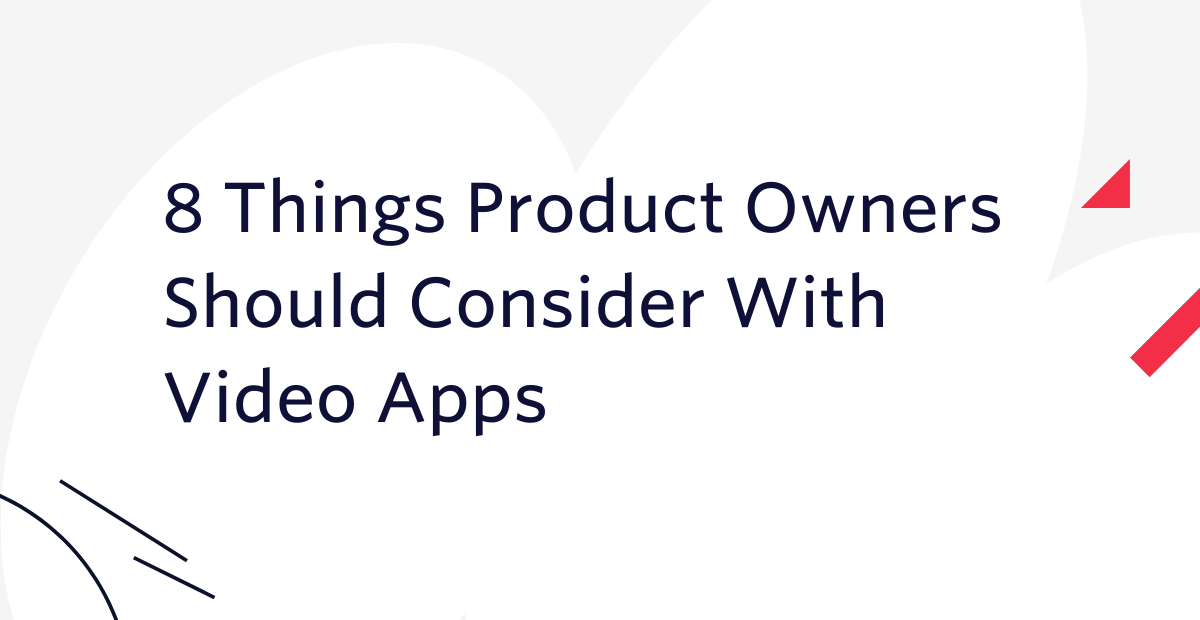8 Things Product Owners Should Consider With Video Apps
Time to read: 5 minutes

Video applications are critical in today’s technology landscape and have played a crucial role in getting the world through the COVID-19 pandemic. Twilio Programmable Video is a great way to get started with building live video apps, in part because it’s straightforward for developers to use. Still, when building a live video application, there are important things that a product owner should consider.
Below, I’ve shared 8 items that other product owners and leads should consider when using video in their application.
8 video app considerations for product owners
Let’s look at the top items you should consider with your video applications.
1. End-user demographics
Who will use your video application determines a lot, including how to design it and other important features.
Is your application going to be used by medical professionals or techies? Does your user base consist of Baby Boomers or Generation Z? Each of those demographics thinks about and uses web apps very differently. So even if you have a great user interface/user experience (UI/UX) designer on your team and they come up with the greatest, most modern look and feel for your app, if it's going to be used by people that don't value these traits that much, then your users could end up disoriented and may not get the most advantage from your app.
2. Latency vs. video quality
Deciding how to trade off latency vs. video quality gets at what users value the most in your video application. Do they need a very low latency solution because having the video synced up across users or delivered near real time is crucial? Or, is it preferable if the video has higher latency in favor of providing higher quality video?
The use case and purpose of your application will drive how you tune the video stream. For example, doctors conducting a remote medical visit may need to see high-quality video of a patient to conduct a remote exam. Sports fans may also want high-quality video, but low latency may be more important if they use a watch-party application with friends.
3. Browser permissions
For browser-based applications, users will have to allow your application to access their camera and microphone to connect properly.
While the interface for this varies slightly from browser to browser, you shouldn’t assume all your users have enabled these permissions beforehand. Build in prompts that explain they must give the app permission to use their camera and how to fix it if they accidentally click the “Decline” button.
4. Waiting rooms
How will users prepare for their video experience?
Assuming your app is some sort of video chat application, then your application must handle participants arriving at different times. A waiting room is important if the call won’t start until the meeting host arrives or before a second person joins. The design is also crucial to your end-user experience since it’s not ideal for your users to stare at an empty room, black screen, or their own image, wondering why no one else is there yet.
In addition, the design and flow of the waiting room can really enhance the value of your video application, making it something more unique than a standard conference “waiting for host to start the call” dialog box.
In a telehealth application, for example, the patient should know that the doctor is on their way and will join them soon. Perhaps someone from the doctor’s office should be able to text with the patient while they wait? Maybe there are online forms the patient should fill out while they wait? Or, maybe there are videos or other content that the patient would benefit from seeing while they wait for the doctor to join the video call?
5. Connectivity tests
Help your users to help themselves.
A connectivity test is always a good idea in a waiting room, but it can also provide useful feedback to users throughout the video experience. If you detect that a user’s connection is degrading, it’s best to let them know before their connection fails and the user blames your application.
Try to keep connectivity tests as fast, simple, and visually friendly as possible. If the call is ready to start or the user has rejoined an existing call, don’t force them to go through any time-consuming connectivity tests. Gather the data you can but also focus on getting them into the video experience as quickly as possible—that’s why they came here.
6. User flow for rejoining a call
For a variety of reasons, users sometimes leave the video conversation. Whether it’s because of a dropped connection or someone at the door, remember that users won’t always join your video experience once and stay put the whole time.
Consider the user flow when users try to rejoin an existing call and make this process quick and painless.
7. Call data for customer service
Starting with your connectivity tests—and throughout the video experience itself—it’s generally a good idea to store some information about the user’s experience.
Track things like their bandwidth connection and the browser they use. Also, store any errors encountered, especially with failures to connect to the call.
No matter how good your application is, there will be times when customers contact your support team with concerns. Being able to look up the details of their specific situation goes a long way to creating satisfied users. You’ll also be able to provide more details to your technical team about what happened and the user on why their connection failed (and, hopefully, how to prevent it in the future).
8. Technical prototypes
If this is the first time your team has built a video application for your use case, then definitely plan some extra time upfront for them to build a technical prototype and test it in real-world conditions. Don’t wait to build every aspect of your UI before confirming that you’ll have the quality and UX you desire in your application’s specific use case!
For example, an application that has 2 users in a video chat can be quite different from a large group chat. Webinar-style applications or interactive video broadcasting also have different user experiences, and all these experiences can vary widely based on the typical devices and network conditions that your users will use and face.
Are your users typically out in the field on a low-strength cellular connection? Will they be within a corporate firewall with restrictive access? Or, are they at home on a high-speed connection?
Using Twilio Programmable Video provides you with a strong foundation for your video application. However, you should still always allow time to test your application in real-world conditions so that you can adjust that experience before worrying about smaller details in the application UI.
Build video applications with Twilio Programmable Video
Video applications are about much more than the technology involved, and it’s important that business and technical leadership consider the technology and design choices along with developers. Product owners, in particular, play a key role in their teams’ ability to deliver a high-quality video application. Thinking about items like call quality, waiting rooms, connectivity tests, and call data will all help the product owner to guide their team into building a more functional video application that users will love.
Twilio Programmable Video delivers both the UI and UX that developers and users alike need to build a fast, simple, and visually friendly video experience. Learn more about incorporating the above 8 considerations into your video experience and get started setting up your live video applications by clicking here to contact our team of experts.
Related Posts
Related Resources
Twilio Docs
From APIs to SDKs to sample apps
API reference documentation, SDKs, helper libraries, quickstarts, and tutorials for your language and platform.
Resource Center
The latest ebooks, industry reports, and webinars
Learn from customer engagement experts to improve your own communication.
Ahoy
Twilio's developer community hub
Best practices, code samples, and inspiration to build communications and digital engagement experiences.


